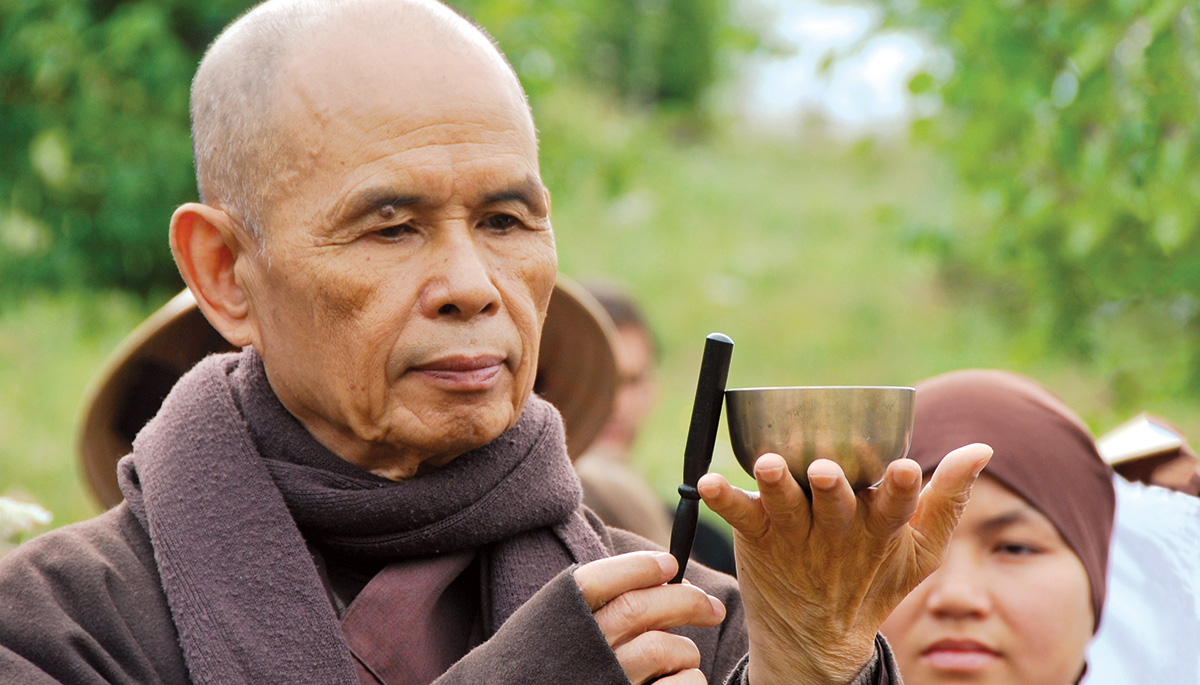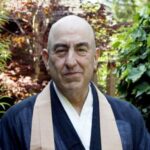Thich Nhat Hanh wears the simple brown robes of a monk, and he has always walked and spoken mindfully as a Zen teacher, poet, and bridge between the world’s faiths. But the strength of steel lies just below his placid surface. It has made him a kind of Buddhist revolutionary.
I recall Zen teacher Richard Baker’s description of Thich Nhat Hanh as “a cross between a cloud, a snail, and piece of heavy machinery—a true religious presence.” He is now well into his nineties, and his health is not what it once was, but his wisdom and influence are completely alive and essential.
When I started working at the Buddhist Peace Fellowship in the early 1990s, there was a broadside hanging over my desk with an excerpt from Thich Nhat Hanh’s book Peace Is Every Step. In part it read:
Mindfulness must be engaged. Once there is seeing, there must be acting. Otherwise, what is the use of seeing? We must be aware of the real problems of the world. Then, with mindfulness, we will know what to do and what not to do to be of help. … Are you planting seeds of joy and peace? I try to do that with every step. Peace is every step … Shall we continue the journey?
The disarmingly straightforward wisdom of Thich Nhat Hanh—more familiarly known to his students as Thay, meaning master or teacher—was tempered in Vietnam’s anti-colonial struggle against the French and the devastation of the U.S. war that followed. In the face of these conflicts, Thich Nhat Hanh brought a nonviolent movement to the Buddhist monasteries. In order to train his students to do social work in rural Vietnam, he created the School of Youth for Social Service.
“So many of our villages were being bombed,” Thich Nhat Hanh said. “Along with my monastic brothers and sisters, I had to decide what to do. Should we continue to practice in our monasteries, or should we leave the meditation halls in order
to help the people who were suffering under the bombs? After careful reflection, we decided to do both—to go out and help people and to do so in mindfulness. We called it ‘Engaged Buddhism.’”
In the mid-sixties Thich Nhat Hanh was exiled from Vietnam—an exile that continued until 2005. Mistrusted by both the communists and nationalists in his own country, he steered a middle way of Buddhist-based nonviolence. In the U.S. he found like-minded comrades in Martin Luther King Jr., Thomas Merton, the radical Catholic Berrigan brothers, Western Buddhist teachers and students, and activists within the nonviolent circle of the Fellowship of Reconciliation and the Buddhist Peace Fellowship.
I began reading Thay’s books in the 1980s, starting with The Miracle of Mindfulness and then Being Peace, the first Parallax Press book. After Being Peace, the stream of published words by Thay became a wide river, with brilliant commentaries on classic Theravada and Mahayana sutras, radical reinterpretations of the bodhisattva precepts, and Buddhist social commentary on our troubled modern world. As they rolled off the presses, his books were eagerly read by so many of us in the Buddhist community.
At the heart of his teachings Thich Nhat Hanh has driven home the centrality of mindfulness as the core of Buddhist practice. It’s fair to say that the flowering of our pervasive contemporary mindfulness “movement” has grown from the words of Thich Nhat Hanh.
As director of the Buddhist Peace Fellowship all through the 1990s, I was asked by Thay and his growing community to organize biennial talks at the Berkeley Community Theater, which accommodated four thousand people. The first talk I organized was in April 1991 in the immediate aftermath of Desert Storm, the first U.S. war against Saddam Hussein’s Iraq following its invasion of Kuwait, and the police beating of African-American Rodney King in Los Angeles.
I was struck by Thay’s comments that night. He spoke of his deep anger over the war in Kuwait and the beating of King, both of which seemed to trigger for him painful memories of the war in Vietnam and the brutal ignorance of U.S. oppression. He said he had considered cancelling his tour, with all its retreats and dharma events.
His words revealed to me that he wasn’t an unreachable saint, but a man with raw feelings. Then he shared that he’d meditated on his own reactivity and realized that he had to continue his tour as planned, because these oppressors and victims—the police, Rodney King, U.S. soldiers, Iraqis, and all their government leaders—were neither different from nor distant from himself.
That same week, in a Los Angeles Times op-ed, Thich Nhat Hanh wrote:
Looking more deeply, I was able to see that the policemen who were beating Rodney King were also myself. Why were they doing that? Because our society is full of hatred and violence. Everything is like a bomb ready to explode, and we are part of that bomb. We are co-responsible for that bomb. That is why I saw myself as the policemen beating the driver. We all are these policemen.
This insight about interdependence is what I have learned from Thich Nhat Hanh. It has infused how he has taught and walked in the world, but it is not a special vision of his own. Such insight appears to Buddhist and spiritual teachers of all lands and ages. It comes from poets and seers. Walt Whitman wrote: “I am large, I contain multitudes.”
Let us strive to be like Thay, that is, let us strive to be truly human, our true selves.

